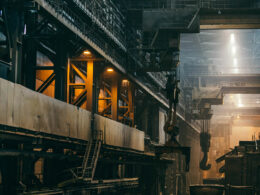We had a privilege to interview a highly experienced supply chain professional and inspiring leader Jukka Ahvonen about digital transformation. We asked him about the challenges that manufacturing companies are facing today and where should manufacturing executives focus on their digital transformation journey.
1) Can you please introduce yourself briefly?
I have been in the production and procurement arena for 27 years. From the seven years of production experience, I spent 3 years establishing a green-field industrial gear manufacturing plant in Tianjin, China and leading the production. I changed to procurement in late 1999 and have gathered wide procurement leader experience in big corporations like Metso Minerals and Outotec, where I was heading the global procurement functions.
I am enthusiastic about procurement issues and love working in this field, and that’s why I have been also an active member of the Steering team of Procurement Forum in LOGY (=Finnish Association of Purchasing and Logistics). I also do pro-bono lectures for procurement students as well as have acted as a mentor for your procurement and SCM professionals.
I decided to jump into more entrepreneurial role 3,5 years ago and joined in Global Sourcing Finland Ltd (GSF) as a partial owner. Here I can use the skills and networks gained over these 27 years for own company benefit. We are serving Finnish medium and small size companies in their sourcing needs, especially from BCC-countries (Best Cost Countries). We work in FAAS-approach (Factory-As-A-Service), where we don’t own any own factories but instead work with long-term partners in certain countries in a very deep collaborative approach.
2) What are the 2-3 major challenges manufacturing companies are solving or redesigning in their supply chains today?
One of the biggest challenges the manufacturing companies and their supply chains are facing is the skilled labour shortage. Although automation is getting all the time bigger role in factories and replacing certain jobs, there is an ever-increasing need for higher-skilled labour to operate the sophisticated automation in the factories. And these new jobs might require new sets of skills, which the current employees don’t necessarily have. This raises the need for training existing employees to cope with the new skills or to recruit new people who already have these skills. Also, the recruiting channels need to be thought, and more and more recruiting is happening via social media channels and through people’s networks. The company’s brand and image must very positive to attract the best young talents.
The era of the mass-produced one-size-fits-all type of products is getting to an end and individualism is taking more and more place. In the product world this means tailor-made individual products. Obviously they can not be in most cases truly 100% tailor-made but compiled together from the configurable limited number of modules to be chosen from. E.g. car industry has been a forerunner in this for years / even a decade already. You can design your own car (colours, interiors, sound systems, engines etc..), but still, they are assembled from standard pre-defined modules. This same thinking is entering also to the other product markets. This means huge changes in the manufacturing plants and their supply chains, which must tolerate completely different kind of flexibility and scalability needs during the digital transformation journey.
Growth of sustainability and especially environmental consciousness is changing the way how consumers and customers make their final purchasing decisions. The manufacturing companies have started to pay attention to this already for some time. But unfortunately, I still see too much of ignorance in these issues in many factories, which I have visited. And sometimes it requires boldness and courage to live according to these values. There was one nice example from my former workplace, where we lived up to our values. We had two supplier alternatives for one product. The Chinese supplier used certain chemical which was completely legal in that country, but in Europe it was not so much preferred due to the dangerous fumes it generated during the manufacturing process (however it was not illegal substance in Europe either, but still a potential threat to humans and environment, if the process would fail). And on the other side of the scale, we had 2 Meur worth of annual savings, if we would choose that Chinese supplier. We had deep internal discussions on the case and decided to live according to the company’s values of sustainability and decided for the European supplier and ignoring those 2 Meur savings.
3) Where should the focus of development be to become a world-class player in SCM as a manufacturing company?
The world is getting all the time more complex with the requirements of individualism, flexibility, scalability and faster delivery time needs. The supply chains should be able to cope with these and typically it requires different skillsets and mindsets from the people. The factories must change their engines to support these needs during the digital transformation journey. Sometimes instead of giga-size factories, there might be a need for smaller-scale factories closer to the end customers. In general, I believe that the network of supply chains must consist of a combination of all these three kinds of suppliers: global suppliers, regional suppliers and local suppliers. It depends very much product-by-product which of these three supplier-types are most suitable for each case. And sometimes the modules manufacturing could be done in those global big factories and then the tailor assembly from these modules is happening in regional and local assembly factories.
4) Your 3 tips to the manufacturing companies who are planning their digital transformation journey?
There is a lot of hype and beliefs about Industry 4.0 and IoT changing the game in many areas. Obviously these will have changes in many areas and in some areas even profound ones, but I still feel that people should be filtering a bit these over-reactions and hype in many cases. But one thing for sure is that cybersecurity will be extremely important in this connected world. Points of vulnerabilities must be constantly scanned and protected with fail-safe systems.
And for digital transformation timeline for actions, my opinion is, that starting with smaller steps (e.g. starting with some pilot cases as POC and based on the feedback expanding further) is better than waiting for the perfect strategy. The digital world is changing so rapidly, that if we fine-tune the perfect strategy for months and years, there might already be new solutions in the market making the strategy partially void. However, I am not saying that there shouldn’t be a digital transformation strategy, there absolutely must be some long-term vision and strategy, but it shouldn’t take too long to make it perfect. Companies should also remember, that digital transformation journey isn’t only a set of new tools and gimmicks, but it might have profound changes in the company’s overall way of making business as well as internal processes.
The digital transformation journey is not concerning just some individual functions of the company (IT, production etc..) but instead, it should be a whole supply chain ecosystem development extending to your suppliers as well as customers. There are a lot of threats, open questions and cultural blocks in employees minds, so proper change leadership and transparent communication is a must. According to one CGI-study, 72% of the manufacturing clients stated that internal resistance and lack of change management are the biggest obstacles in the digital transformation journey.










